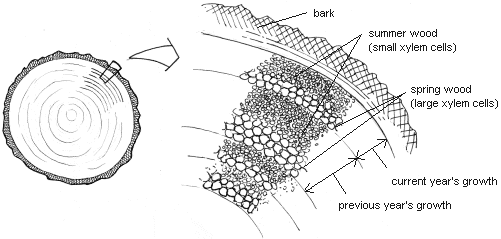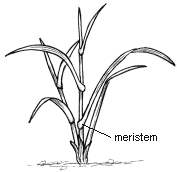Cross Section of Tree Trunk Showing Rings
Intercalary meristems. In most plants the primary
meristem is located at the tip of the growing shoot—we're all familiar with the rapid
growth of a morning glory vine, for example. But consider your lawn. If you cut off the
meristem every time you mow the lawn, how does the plant regrow so quickly?
In prairie habitats, plants are continually exposed to
grazing by deer, bison, and other herbivores. Plants with apical meristems would
repeatedly lose their growing points and therefore their primary means of regenerating.
Grasses, however, adapted by locating their meristem tissue at nodes along the stem, just
above ground level. Grasses continue to grow from these intercalary meristems and can repeatedly
renew themselves after grazing by animals (or by humans during their weekly mowing!)
Intercalary Meristem


|
|

Counting the Years
When you cut a tree
trunk and count the rings, you are actually counting the layers of secondary xylem
cells. In the spring, the tree produces large xylem cells; throughout the growing season,
the xylem cells produced become progressively smaller. This forms a pattern of rings.
Scientists have been able to date weather patterns and environmental disruptions based on
the relative size of the annual rings of ancient trees.
No More Mowing!
How did these high-maintenance
prairie plants become so popular in our lawns anyway? And now that natural grazing
pressure is gone, why don’t we change to a plant that naturally stays low growing?
Why is the expansive
"golf course" grass lawn the ideal, rather than, say, the bugleweed
"lawn" or the wooly thyme "lawn" or the creeping juniper
"lawn?" In areas with little foot traffic, these naturally low-growing ground
covers would require little if any maintenance, and certainly no weekly mowing.
It’s time for a revolt!
No more mowing! Let’s change the ideal from a lawn of grasses with intercalary
meristems to a lawn of naturally low-growing ground covers. Let’s spend our weekends
tending our vegetable and flower gardens instead of pushing a lawn mower! |
|